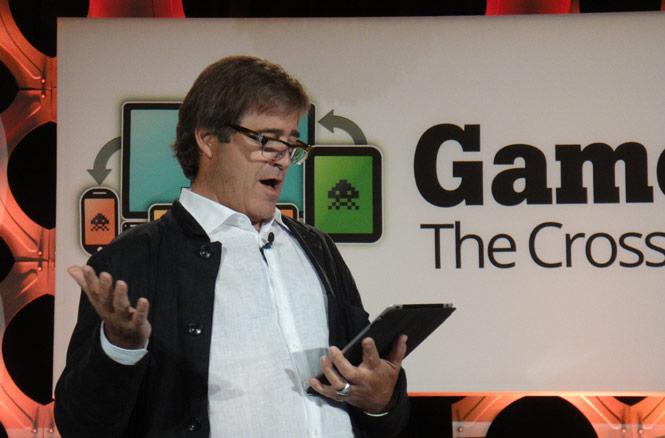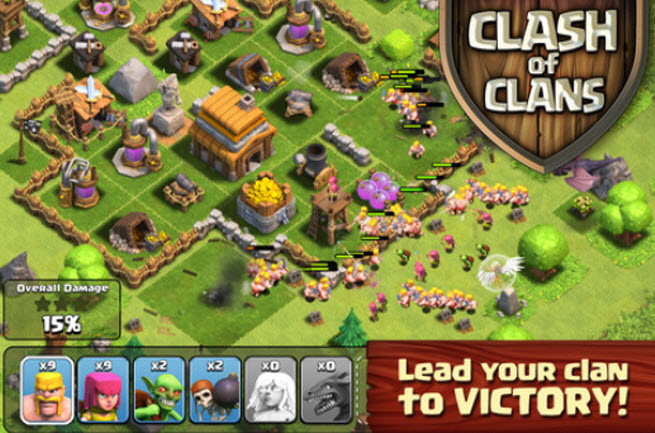GamesBeat: When you think of what happens in console game marketing now versus what happens in mobile games, do you see anything they have in common, or any specific things that are very different?
Gordon: What they have in common is, they all think the console game marketers are going to lose their jobs. In the 2000s, console games were marketed a lot like movies — paid television, a little bit of PR, a lot of retail marketing, and street marketing, trying to get word of mouth among opinion leaders. None of that has worked well for mobile games.
GamesBeat: The console guys seem to spend an awful lot of time on trailers — doing a new trailer every week now.
Gordon: It’s a transition. The people making console games learned the art of making games that were good TV. You tend to keep doing what you’re good at. Right now I think the key in console games is how you keep monetizing your happy customers over time. To the degree that the viral video can get to buy more stuff this month, it probably pays off.
The big difference right now between console games and mobile games is 3D graphics. TV is the only way to show that off. And then the sense of movie-like story quality. Console games keep playing that up. The TV for mobile games, rather than looking like a movie, it up-rezzes all the art. We don’t have the footprint on phones to have all that art as a non-interactive interstitial, so they just run it as a TV commercial instead. That’s very much like the kind of advertising Nintendo could have done for the Game Boy, the original B&W Game Boy. They could have put Kate Upton in Mario and it probably would have had the same impact.
GamesBeat: Some of the mobile advertising reminds me of — it’s playing up the social element of it, like Nintendo did with the original Wii. Instead of showing you the screen, they turned the camera around and showed you all the fun people were having in their living room.
Gordon: I think of the failed launch campaign for the Xbox — “It’s good to play together.” I haven’t seen any TV about social connectedness that I think is very effective. The TV still mostly gets across a great solo experience.
GamesBeat: I did like the Liam Neeson ad Supercell did. He’s trying to get revenge on someone. I guess that’s kind of social?
Gordon: I guess? But it wasn’t showing people playing together. I’ve tried over the years how to get across that social aspect. What the movie business does, they do endorsements where they show people coming out of the theater together. What they really want to show is people kissing in the back row, I think, or somebody screaming and jumping into someone else’s lap. It’s hard to get inventive about social endorsements, showing on video what social is. “Social” sort of becomes a buzzword we use and everyone nods. But that doesn’t work well for marketing. The best video for social marketing comes from the dating apps.
GamesBeat: There’s a good question. What can gaming learn now from other industries when it comes to marketing?
Gordon: We learned from the movie business back in the late ‘90s. Frank Gibeau and Jeff Karp were experts. They brought the movie business to games. Blizzard did not get across the social element of World of Warcraft, all the guilding. Clash of Clans doesn’t know how to get it across.
I think there’s a lot to learn from dating. I did a talk three-four years ago about how online customer management is like a dating app. I showed side-by-side comparisons of graphs from OKCupid and various game product management graphs. There’s not a lot of new paid media. Right now the games business hasn’t really learned about Google advertising yet. We’re still kind of stuck with the movie business.
I do think there’s stuff going on in short-form online video that’s pretty interesting. There’s stuff going on with YouTube and the various creators there. How they build an audience is interesting. But there doesn’t seem to be very many people who are thinking across games and new video simultaneously.
GamesBeat: Switching gears slightly, what’s your view of the investment environment around games? Does some of this affect what you decide is going to be a good investment in 2015?
Gordon: In games I’ve seen a lot of things. The question is, with any consumer-facing product, can you afford to invest ahead of proven traction? It’s pretty awkward to invest before traction, especially in venture, because if you do — If you stick with that company for five or six years, even if you like them, and they don’t get traction, you’re kind of boxed out from competitive investing. The only reason to invest ahead of proven traction is if you really believe in the founding team. It’s hard, in games, to show a prototype or a Powerpoint and make it worth investing.
We’ve seen stuff like QuizUp that got invested in at a really high valuation after a meteoric 30-day rise. It still seems like premature investment.
GamesBeat: A lot of the money seemed like it was all going to go for user acquisition. In that case, if you know you’re putting $10 million into a company, and they’re going to use it for user acquisition, does that make you feel good?
Gordon: It depends how valuable the consumers are. You’re always betting that a company will figure out how to be long-lasting, get increasing returns, and keep customers for a long time.
GamesBeat: There are these new categories that always pop up. Virtual reality and augmented reality are the darlings right now. There’s also some interesting server infrastructure companies, like Improbable and Shinra. What do you think of those categories?
Gordon: I hope that VR happens. It’s another potential step in high resolution. Since I’ve been in the games business, every six years there’s a new generation. The first year or two it seems like a miracle, like you’re immersed in some all-new thing. Then, by year three, you see around the edges and you get used to it. By year four or five you’re bored and hoping for the new thing.
I think virtual reality shows great promise — a lot more immersion. The difference here is that in addition to the sense of immersion through ears and eyes, it seems to also get your inner ear involved. Your body’s affected more than in anything I’ve ever seen. That might make this feel simultaneously like two generational steps, if Carmack can make the graphics look good enough.
GamesBeat: You could combine it with your Apple watch, right?
Gordon: Ha! VR in general has earmarks of really high consumer demand. It looks like it’s coming to market more slowly than originally anticipated. It’s very difficult for a successful game company to spend a lot of time on it now, because it’s happening slowly. But it’s wildly interesting.
As far as live services, we’ve seen it with AI, we’ve seen it with 3D, and we’ve seen it in analytics. People could build a layer, the tech stack, and become valuable. In the early days of AI, of Havok, and of 3D, these were frameworks that over time became more battle-hardened. We’ll see the same with live services. 3D, engineers liked doing it, but it was hard to get performance. AI, engineers didn’t like doing it, but Havok could get performance. With live services, nobody likes to do it, but it’s important. The stuff nobody likes to do, or that people can’t do, is often a good thing to create as an independent service layer. It’s a hard way to make a living, but if things go right you can build a dominant position.
GamesBeat: What do you think of some of the categories that seem like they might be past their prime as far as investment opportunities? With social casino games, in 2015 the successful ones seem to be run by the big companies now.
Gordon: The category is here to stay. The question is, is there more innovation ahead? There’s always more innovation ahead, I think, but it has to happen through people. It doesn’t happen on its own. In these creative businesses, the market grows when people make good stuff. When people get bored of their own success or stop having imagination, then things stall. I think it’s very likely that online casino games are going to have a potential to be 10 times more people than ever go to a real casino in a given year. Whether it’ll reach that or not remains to be seen.
I liken it to NHL hockey. When I started doing the NHL hockey game on the Sega Genesis, people would buy the game who never watched hockey on TV. People would wear hockey merchandise who never went to a game. The NHL stumbled in their marketing to a point where the only people who watched it on TV and bought merchandise were people who went to at least one live game a year. As soon as you lose the imagination of a broader audience, your business gets a lot less interesting. With online casino, the question is, can you keep people involved who don’t go to Vegas or Atlantic City?
GamesBeat: What platform is more interesting — the Nintendo NX, the Nvidia Shield, or something else?
Gordon: I’m not paying attention to either of them.
GamesBeat: The Nvidia one seems to be tied pretty closely to cloud gaming. I don’t know what you think of cloud gaming in general.
Gordon: I’ve seen a couple of them. The world’s going in a different direction, I think. The problems with ping rate and prediction of what other users are going to do are just exacerbated on touch screens and mobile. In general, asynchronous is fine. It’s bandwidth or memory. I just don’t think that games work with the client’s memory constraints, and all the problems of doing processing and rendering in the cloud don’t give much advantage to mobile devices.
What I notice about it is, civilians think it’s cool and gamers don’t. That’s usually a bad formula. It means that civilians invest and then gamers don’t buy. So far, cloud gaming is the Coleco Adam of online. It’s a fake demo that doesn’t actually work when it’s out of the showroom.
GamesBeat: Have you been very active in investing with any particular gaming efforts lately?





